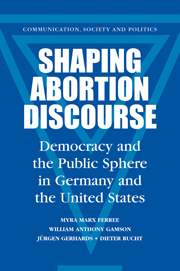Book contents
- Frontmatter
- Contents
- Tables and Figures
- Foreword by Friedhelm Neidhardt
- Preface
- Glossary
- Part I Introduction
- 1 Two Related Stories
- 2 Historical Context
- 3 Methods
- Part II Major Outcomes
- Part III Representing Different Constituencies
- Part IV The Quality of Abortion Discourse
- Methodological Appendix
- References
- Index
1 - Two Related Stories
Published online by Cambridge University Press: 15 December 2009
- Frontmatter
- Contents
- Tables and Figures
- Foreword by Friedhelm Neidhardt
- Preface
- Glossary
- Part I Introduction
- 1 Two Related Stories
- 2 Historical Context
- 3 Methods
- Part II Major Outcomes
- Part III Representing Different Constituencies
- Part IV The Quality of Abortion Discourse
- Methodological Appendix
- References
- Index
Summary
Es [das sich im Mutterleib entwickelnde Leben] genieβt grundsätzlich für die gesamte Dauer der Schwangerschaft Vorrang vor dem Selbstbestimmungsrecht der Schwangeren. It [the life developing in the mother's body] fundamentally takes priority over the pregnant woman's right to self-determination throughout the entire period of pregnancy.
(German Constitutional Court 1975, BVerG 1, 44)The right to privacy, whether it be founded in the Fourteenth Amendment's concept of personal liberty and restrictions upon state action or in the Ninth Amendment's reservation of the rights to the people, is broad enough to encompass a woman's decision whether or not to terminate her pregnancy.
(Roe v. Wade 1973, 410 U.S. 177)At the beginning of a new century, Germany and the United States have arrived at uneasy policy compromises on the vexed issue of abortion. The compromises are in some regards surprisingly similar: In Germany, a woman with an unwanted pregnancy can decide to have an abortion in the first trimester, although she is required to have counseling designed to encourage her to have the child. Access to abortion is relatively simple after a short waiting period. In the United States, the choice of abortion also rests with the woman in the first trimester. The 50 individual states may impose various restrictions as long as these do not place an undue burden on the woman's decision to end an unwanted pregnancy.
In other respects, the situations are sharply different. The similarity of practical outcomes is surprising because the public discussion of abortion and the constellation of actors attempting to shape it provide dramatic contrasts.
Information
- Type
- Chapter
- Information
- Shaping Abortion DiscourseDemocracy and the Public Sphere in Germany and the United States, pp. 3 - 23Publisher: Cambridge University PressPrint publication year: 2002
